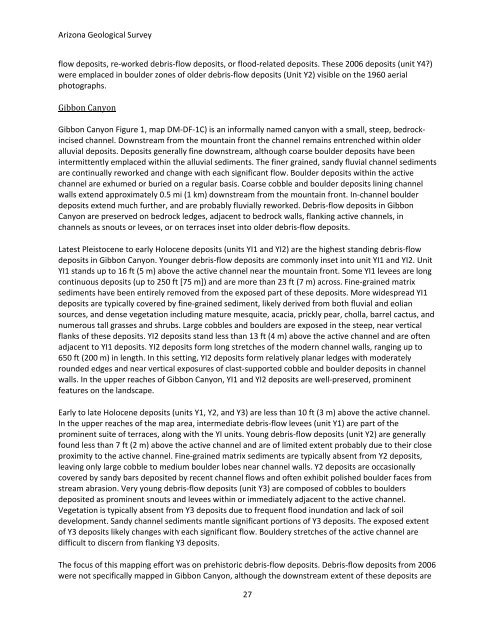Arizona Geological Survey OPEN-FILE REPORT OFR 08-06
Arizona Geological Survey OPEN-FILE REPORT OFR 08-06
Arizona Geological Survey OPEN-FILE REPORT OFR 08-06
You also want an ePaper? Increase the reach of your titles
YUMPU automatically turns print PDFs into web optimized ePapers that Google loves.
<strong>Arizona</strong> <strong>Geological</strong> <strong>Survey</strong><br />
flow deposits, re‐worked debris‐flow deposits, or flood‐related deposits. These 20<strong>06</strong> deposits (unit Y4?)<br />
were emplaced in boulder zones of older debris‐flow deposits (Unit Y2) visible on the 1960 aerial<br />
photographs.<br />
Gibbon Canyon<br />
Gibbon Canyon Figure 1, map DM‐DF‐1C) is an informally named canyon with a small, steep, bedrockincised<br />
channel. Downstream from the mountain front the channel remains entrenched within older<br />
alluvial deposits. Deposits generally fine downstream, although coarse boulder deposits have been<br />
intermittently emplaced within the alluvial sediments. The finer grained, sandy fluvial channel sediments<br />
are continually reworked and change with each significant flow. Boulder deposits within the active<br />
channel are exhumed or buried on a regular basis. Coarse cobble and boulder deposits lining channel<br />
walls extend approximately 0.5 mi (1 km) downstream from the mountain front. In‐channel boulder<br />
deposits extend much further, and are probably fluvially reworked. Debris‐flow deposits in Gibbon<br />
Canyon are preserved on bedrock ledges, adjacent to bedrock walls, flanking active channels, in<br />
channels as snouts or levees, or on terraces inset into older debris‐flow deposits.<br />
Latest Pleistocene to early Holocene deposits (units YI1 and YI2) are the highest standing debris‐flow<br />
deposits in Gibbon Canyon. Younger debris‐flow deposits are commonly inset into unit YI1 and YI2. Unit<br />
YI1 stands up to 16 ft (5 m) above the active channel near the mountain front. Some YI1 levees are long<br />
continuous deposits (up to 250 ft [75 m]) and are more than 23 ft (7 m) across. Fine‐grained matrix<br />
sediments have been entirely removed from the exposed part of these deposits. More widespread YI1<br />
deposits are typically covered by fine‐grained sediment, likely derived from both fluvial and eolian<br />
sources, and dense vegetation including mature mesquite, acacia, prickly pear, cholla, barrel cactus, and<br />
numerous tall grasses and shrubs. Large cobbles and boulders are exposed in the steep, near vertical<br />
flanks of these deposits. YI2 deposits stand less than 13 ft (4 m) above the active channel and are often<br />
adjacent to YI1 deposits. YI2 deposits form long stretches of the modern channel walls, ranging up to<br />
650 ft (200 m) in length. In this setting, YI2 deposits form relatively planar ledges with moderately<br />
rounded edges and near vertical exposures of clast‐supported cobble and boulder deposits in channel<br />
walls. In the upper reaches of Gibbon Canyon, YI1 and YI2 deposits are well‐preserved, prominent<br />
features on the landscape.<br />
Early to late Holocene deposits (units Y1, Y2, and Y3) are less than 10 ft (3 m) above the active channel.<br />
In the upper reaches of the map area, intermediate debris‐flow levees (unit Y1) are part of the<br />
prominent suite of terraces, along with the YI units. Young debris‐flow deposits (unit Y2) are generally<br />
found less than 7 ft (2 m) above the active channel and are of limited extent probably due to their close<br />
proximity to the active channel. Fine‐grained matrix sediments are typically absent from Y2 deposits,<br />
leaving only large cobble to medium boulder lobes near channel walls. Y2 deposits are occasionally<br />
covered by sandy bars deposited by recent channel flows and often exhibit polished boulder faces from<br />
stream abrasion. Very young debris‐flow deposits (unit Y3) are composed of cobbles to boulders<br />
deposited as prominent snouts and levees within or immediately adjacent to the active channel.<br />
Vegetation is typically absent from Y3 deposits due to frequent flood inundation and lack of soil<br />
development. Sandy channel sediments mantle significant portions of Y3 deposits. The exposed extent<br />
of Y3 deposits likely changes with each significant flow. Bouldery stretches of the active channel are<br />
difficult to discern from flanking Y3 deposits.<br />
The focus of this mapping effort was on prehistoric debris‐flow deposits. Debris‐flow deposits from 20<strong>06</strong><br />
were not specifically mapped in Gibbon Canyon, although the downstream extent of these deposits are<br />
27
















